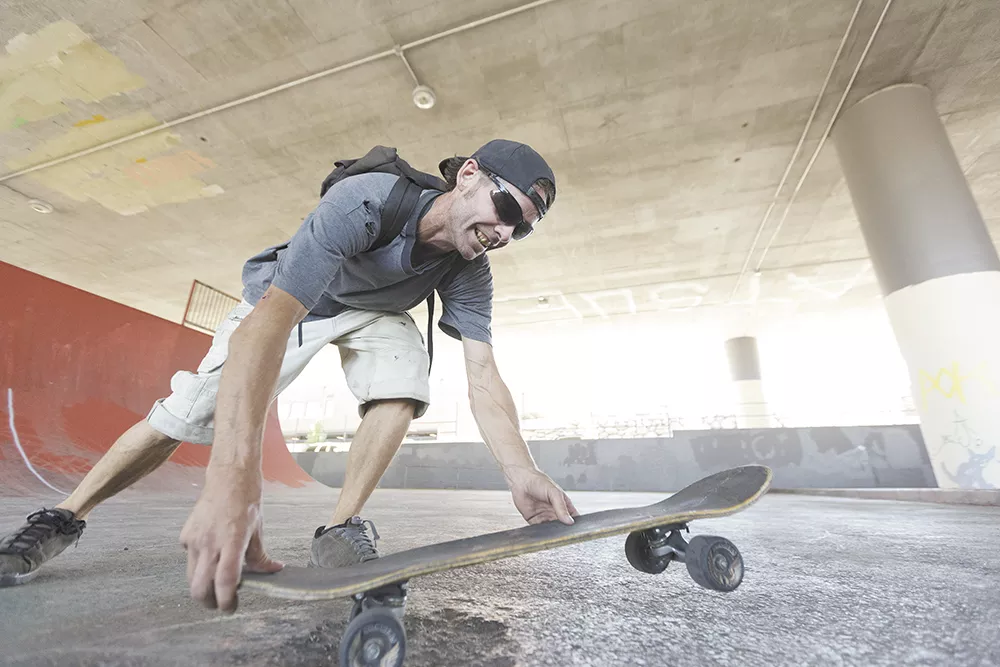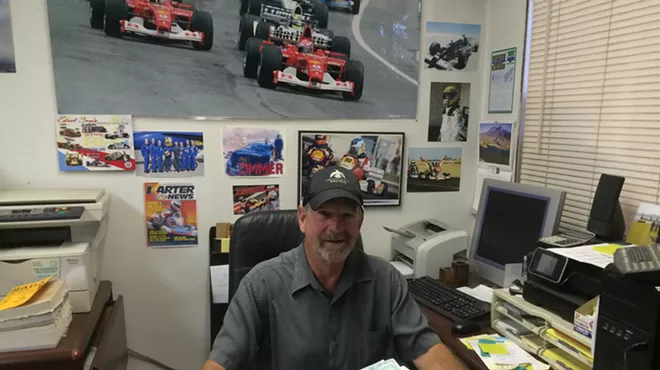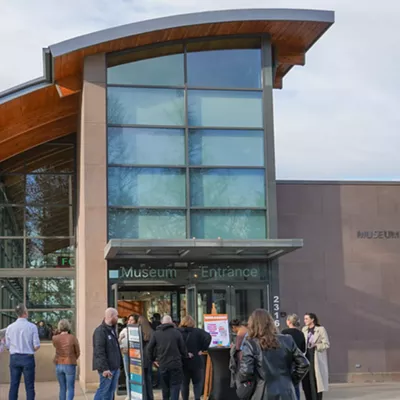When Jayme Scamolla was 12, he snapped his arm in half on the blood-red quarter pipe under the freeway. He doesn't remember a fellow skater taking him to the hospital or the doctor popping his arm back into place, but the now 29-year-old does remember the lessons he learned.
First, Scamolla learned how to distribute his weight so the board wouldn't fly out from under him again. His success taught him the value of perseverance. He started skating again the week after he got out of the hospital, his arm still in a cast. The fellow skaters' kindness taught him about camaraderie. He didn't know the dude, but those actions showed him the importance of looking out for one another.
On a steamy afternoon in late July, Scamolla is telling the story of his first broken bone and how he learned to skate, knowing that this week the city was going to demolish the skatepark under I-90 known as the Under the Freeway (UTF) Skatepark.
"I started crying the other day when I heard," Scamolla says. "For a lot of us, it's heartbreaking because this was the first park we skated."
The demolition started on Monday, and the city Park Board has been discussing construction of a new downtown skatepark; however, nothing is set in stone. Local skaters are bummed to see the iconic park go and worry about where they're going to skate in the winter. UTF Skatepark, the city's only covered public skatepark, was a haven for bad-weather skating. However, due to its modular design, skaters didn't use it as often as the two other parks in Spokane.
Another reason that some stayed away: the crowd of non-skaters who gather there.
Last week, a lone skater starts from across the street to pick up enough speed for a backside ollie floater. It takes him a few tries, but eventually he nails the landing. Before he could start skating, though, he had to pick up the needles.
"I've run over needles and caps and shit before," says the 45-year-old man named Trevor, who declined to give his last name. "The reason people don't come down here as much anymore is because of all this mess. Put in some more ramps and more skaters will show up and kick them out of here. I guarantee that."
Trevor is referring to the people who buy and sell drugs in the park, but not all non-skaters come for that. A lithe 42-year-old named Bobby wearing a black Spokompton T-shirt has come to the park in its final days because a friend just gave him a new BMX-style bike frame, and he needs more parts.
"It sucks," he says of the park's impending demise. "I spend a lot of time down here, and there's times when this place is packed with skaters."
From the back of a van next to the park, Bobby procures the parts to build an entire bicycle, and then he does. When a woman who is working on her own bike asks him for a tool, he gladly hands it over.
"We share stuff when somebody needs something," he says. "That's 'cause if I ever need something, it'll come back to me."
Although he doesn't skate, the park is a community gathering place for Bobby. He says that a lot of people sleep in the park. Its concrete perimeter walls offer protection from the wind; the freeway offers protection from rain and snow.
Another reason the city is doing away with its oldest skatepark is because it sits on land leased from the state Department of Transportation.
"We want to make sure we have ownership of the land so we can maintain it," says Monique Cotton, a city spokeswoman. "We didn't have much control over the lighting and making investments into the property because we were renting it."
Although the city's lease isn't up until 2021, the Parks and Recreation department started making plans in 2012 to demolish the UTF Skatepark and build a new one somewhere else. Since then, it has contracted with Grindline Skateparks, a world-renowned, Seattle-based skatepark construction company, to identify possible locations and estimate costs. Grindline's report, which estimates that a new park will run the city about $700,000, also identified three possible central locations: Liberty Park, A.M. Cannon Park and north Riverfront Park — the favorite among local skaters. The city has earmarked $288,000 for a possible new park, but that figure and the location still have to be approved by the Park Board.
Although a new skatepark is not guaranteed, the board is committed to future discussions. "That money is still allocated to a skatepark," says Chris Wright, president of the Park Board. "I don't think the board would ever take it out."
If a new park ultimately is approved, the city will open discussions with the community to find out exactly what kind of skatepark they want, Cotton says. As of now, there is no timeline for when construction on a new park could begin.
Skateparks are important. They are representative of a city's recognition of an alternative athletic culture, one that doesn't conform to teams, coaches and regular practices.
"It seems like it's always been the kids from the 'wrong side of town' who end up riding skateboards," says Chad Balcom, a board member of Skaters for Public Skateparks, a Portland nonprofit that advocates for skatepark construction. "And those are the kids that need recreational opportunities most."
Marni Goldenberg, a professor at California Polytechnic State University at San Luis Obispo, says skateparks go far beyond a place to exercise and a distraction from trouble. Her research focuses on skaters' opinions of why they use skateparks. Among the most prevalent reasons were camaraderie, social opportunities, skill development and stress relief.
Becky Beal, a professor at California State University East Bay, has been researching skateboarding culture for the past 25 years. She says that a new skatepark doesn't necessarily guarantee a benefit to the city.
"It's really important to involve advocacy groups of skaters so their voices can be heard," she says of a city's decision to build new parks. "If it's done right, they can serve as places to learn to skate and build community with each other."
Spokane will be left with two outdoor public skateparks now that UTF has been demolished; by contrast, Beal says that skatepark construction around the county is skyrocketing.
Since 2002, for example, the Tony Hawk Foundation has contributed to 556 construction projects throughout all 50 states; 466 of them are now open.
Last weekend, skaters of all ages from Spokane and beyond came to pay their final respects. Sweat dripped from Jordon Graham's chin as he waited in line to grind the only flat rail in the park."This place is pretty gnarly," he says. "I met a bunch of the homies down here, and I'm sad to see it go."
As Graham waited his turn and answered questions about what he'd like to see in a new skatepark, others launched off the quarter-pipe ramp behind him and shredded over the nearby pyramid. More people took breaks on the edges of the park and scarfed hot dogs. The scene was much different from the lone midday skater outnumbered by the homeless people and drugs just two days earlier. When the skaters showed up en masse last weekend, the non-skaters moved out.
"Let skateboarders design [the new park]. Put in some flat bars and some stairs. Make it so everything doesn't run into each other like at Joe Albi," Graham says, referring to the skatepark in the Dwight Merkel Sports Complex in northwest Spokane.
Pistole Boardshop owner Josh Yandell was there to show his support, too. He's been involved in discussions with the city about where and how to build a replacement for UTF since 2012.
"Our biggest thing is that the new one has to be covered," he says. "These kids skateboard year-round. When they tear this one down, they won't have any place to skate in the wintertime."
Yandell is pleased that the city is talking with Grindline. He says one of the reasons skaters don't come here as much as other parks is because it wasn't designed by skaters. Two of the ramps feed directly into a wall, for example.
That's something Grindline could fix. The city has used the firm to design the Hillyard Skatepark and one at the YMCA in Spokane Valley. Grindline, which has designed hundreds of parks throughout the country as well as numerous parks in Denmark, Israel, Canada and Japan, has earned a good reputation.
"They build some of the best skateparks in the world," Yandell says. "Kids will know, like, 'Dude, that's a Grindline park, let's go there.'" ♦



















